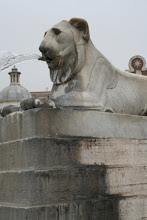 t every window, or at every shopfront. It's a winelover's paradise, and combined with the beautiful renaissance and medieval architecture of the town, the sunny blue skies and the lazy pace we find ourselves relaxing almost immediately. I say almost immediately, as driving through the historic centre, with its tiny lanes and hairpin bends is enough to scare the lights out of both of us. I'm in the passenger seat and I'm nearly as keyed up as Jim, who navigates our car through some impossible-looking turns. The GPS is not being helpful, suggesting we go down yet another impassable street to reach our apartment on the Via del Poliziano. Eventually we turn back and try another approach to the town, much easier this time and park the car with relief. Giacomo, who owns the apartments is very happy to see us, and we are very happy to see him.
t every window, or at every shopfront. It's a winelover's paradise, and combined with the beautiful renaissance and medieval architecture of the town, the sunny blue skies and the lazy pace we find ourselves relaxing almost immediately. I say almost immediately, as driving through the historic centre, with its tiny lanes and hairpin bends is enough to scare the lights out of both of us. I'm in the passenger seat and I'm nearly as keyed up as Jim, who navigates our car through some impossible-looking turns. The GPS is not being helpful, suggesting we go down yet another impassable street to reach our apartment on the Via del Poliziano. Eventually we turn back and try another approach to the town, much easier this time and park the car with relief. Giacomo, who owns the apartments is very happy to see us, and we are very happy to see him.It is lovely here. Montepulciano became part of the Medici empire in the 16th century and there are many palaces, important civic buildings and renaissance artworks. It caters to tourists, but it still has a feeling of living slow. Our windows look out over vineyards and distant hill towns. The valleys are green and sepia with many villas and farmhouses, their approaches lined with dark green cypresses. Far away to our left we can see Lake Trasimeno, the largest stretch of water in Umbria. Below us, an avenue of lime trees leads to the tiny church of Santa Maria.
 Via del Poliziano becomes the main street of the town. It's not cobbled (hooray) but faced with large blocks of stone and the buildings are honey-coloured. Giacomo tells us many Romans have their retreats here to escape the summer heat and we can believe it. It's several degrees cooler than Rome.
Via del Poliziano becomes the main street of the town. It's not cobbled (hooray) but faced with large blocks of stone and the buildings are honey-coloured. Giacomo tells us many Romans have their retreats here to escape the summer heat and we can believe it. It's several degrees cooler than Rome.
 Today we visit the early market in the main Piazza. Facing us, the Palazzo Comunale, with its crenellated tower is a smaller-scale copy of Florence's Palazzo Vecchio. The local artisans have some beautiful items for sale, including papergoods, crafted silver and textiles. Later on this week, Montepulciano has its farmer's market in the lower town and our host tells us it is the best market in southern Tuscany. Aside from wine, the district is famous for pecorino cheese, cured meats, honey and olive oil and the thin hand-rolled pasta, called pici.
Today we visit the early market in the main Piazza. Facing us, the Palazzo Comunale, with its crenellated tower is a smaller-scale copy of Florence's Palazzo Vecchio. The local artisans have some beautiful items for sale, including papergoods, crafted silver and textiles. Later on this week, Montepulciano has its farmer's market in the lower town and our host tells us it is the best market in southern Tuscany. Aside from wine, the district is famous for pecorino cheese, cured meats, honey and olive oil and the thin hand-rolled pasta, called pici.
We have lunch at la Grotta, facing San Biagio, and sitting in the shady courty ard the dome of the church is almost overhead. Service is attentive and very courteous, with many complimentary tastes of wine and food. We finish with a selection of fresh and aged pecorino and goats cheeses, served with pears, local honey and pinenuts. Absolutely satisfied, we begin the steep climb back up towards the town, the only people out walking in the mid-afternoon heat. Most shutters are tightly closed as people take their siesta.
ard the dome of the church is almost overhead. Service is attentive and very courteous, with many complimentary tastes of wine and food. We finish with a selection of fresh and aged pecorino and goats cheeses, served with pears, local honey and pinenuts. Absolutely satisfied, we begin the steep climb back up towards the town, the only people out walking in the mid-afternoon heat. Most shutters are tightly closed as people take their siesta.


No comments:
Post a Comment